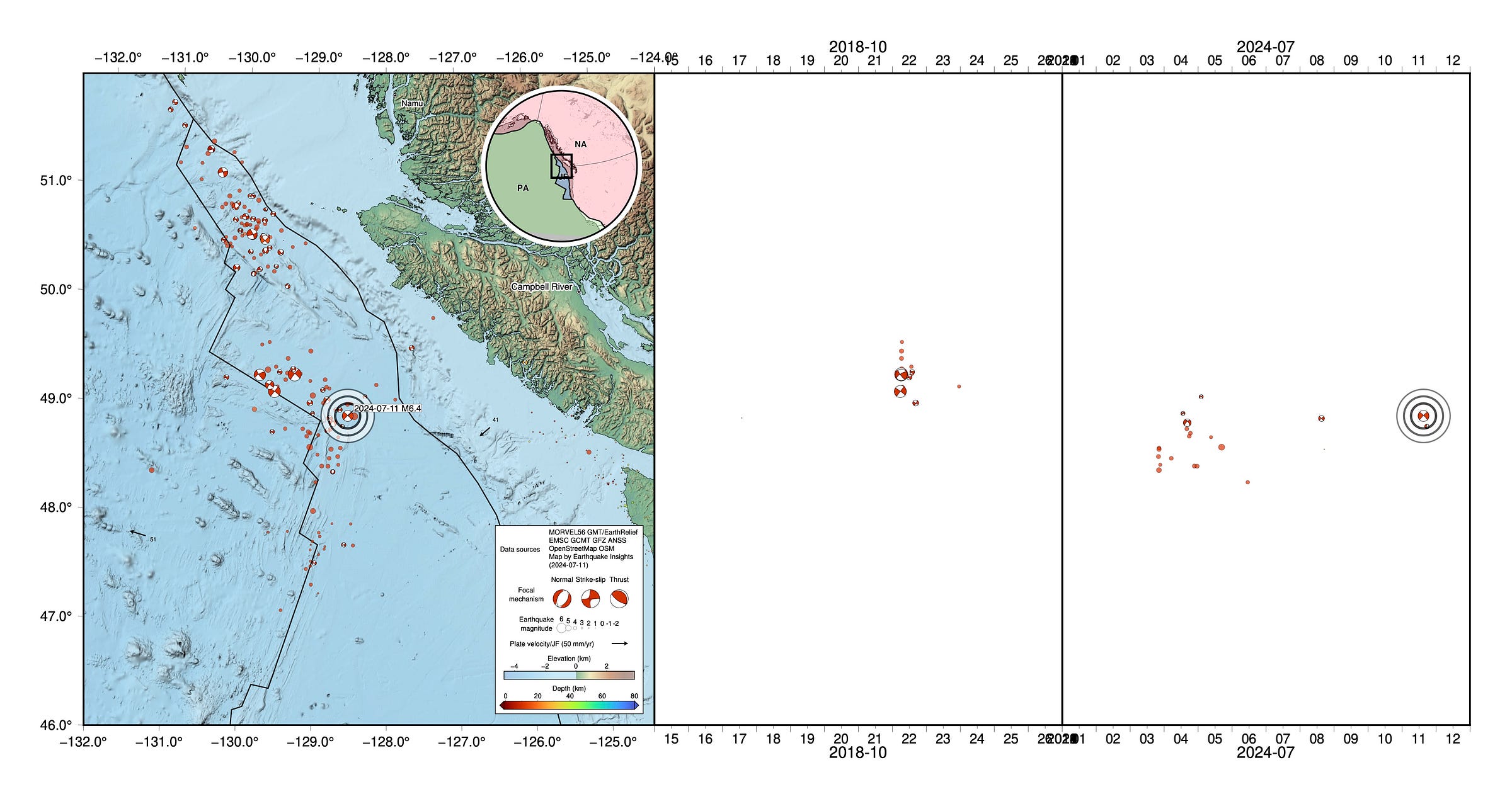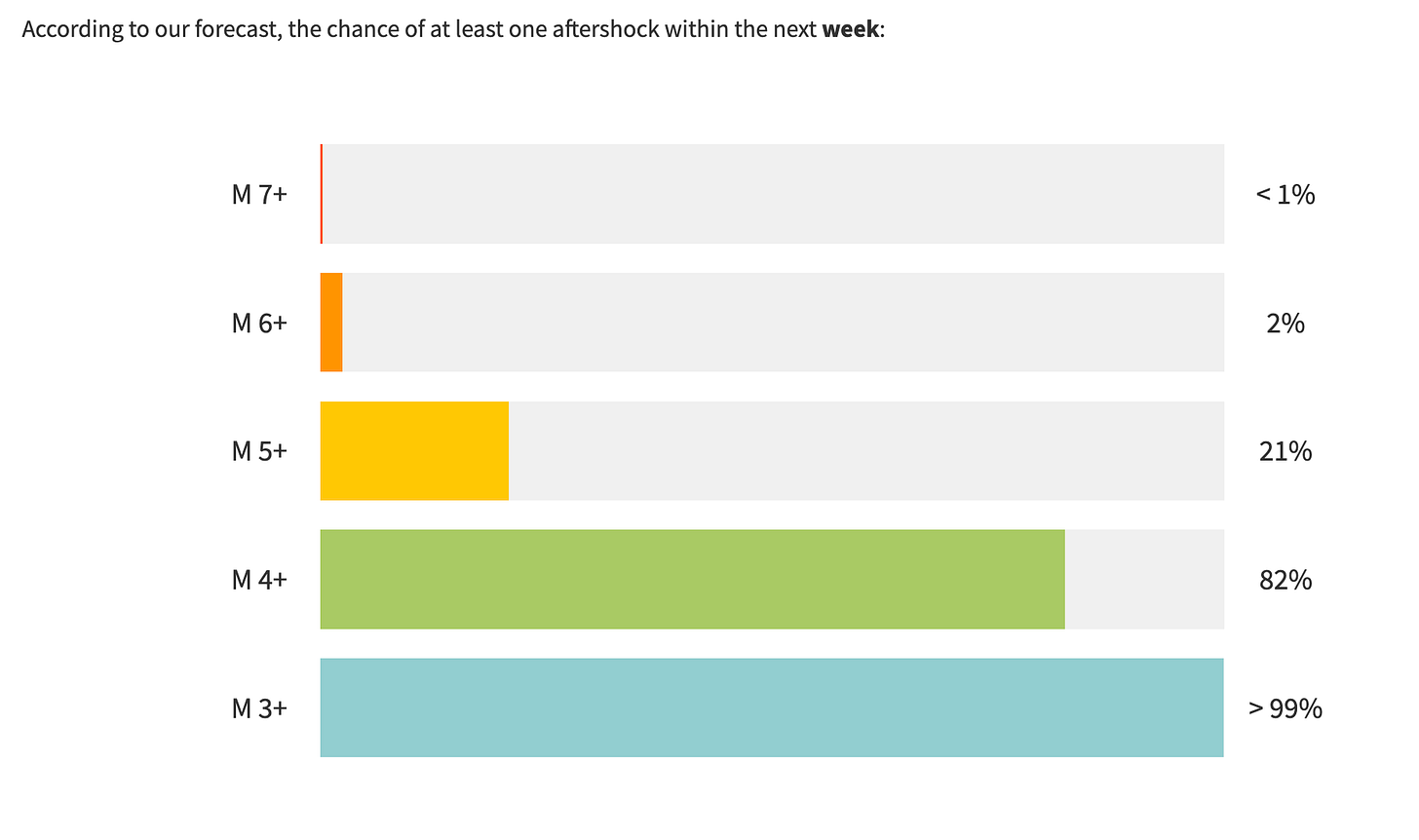Swarm offshore Vancouver Island punctuated by M6.4 earthquake
A combination of oceanic transforms and a small deforming plate makes M6+ earthquakes common here
Citation: Hubbard, J. and Bradley, K., 2024. Swarm offshore Vancouver Island punctuated by M6.4 earthquake. Earthquake Insights, https://doi.org/10.62481/a23a9f0a
Earthquake Insights is an ad-free newsletter written by two earthquake scientists. Our posts are written for a general audience, with some advanced science thrown in! To get these posts delivered by email, become a free subscriber. If you would like to support our work here, please also consider a paid subscription.
Earthquake aficionados may have noticed that a small area offshore Vancouver Island, Canada started to produce moderate earthquakes earlier this month. Starting on July 3, a series of magnitude 4-5 earthquakes was recorded. The tenth earthquake was finally large enough that people on the nearby mainland felt shaking: a magnitude 5.7 on July 4. Over the next few days, more earthquakes, two above magnitude 5. Then, on July 11, seismometers recorded a magnitude 6.4 - releasing more than eleven times as much energy as the previous largest event in the swarm. (Having occurred 170 km offshore of a low-density area, reported shaking still remained at or below intensity IV: light.)

Why are earthquakes occurring off the western coast of North America? Most discussions of seismicity in the Pacific Northwest focus on the really hazardous fault systems: the Cascadia subduction zone (where the Juan de Fuca Plate slides beneath North America), and the various shallow faults on land, like the Seattle Fault. The July 11 earthquake, and the swarm of smaller earthquakes that preceded it, did not occur on either of these systems, but rather on a tectonically important but much lower hazard plate boundary that lies on the far side of the Juan de Fuca Plate.
We wrote about transform faults in our last post: the strike-slip faults that separate segments of oceanic spreading centers. These faults - and the earthquakes that they generate - trace plate boundaries beneath the oceans around the world. If you missed this animation from the EarthScope Consortium in that post, here it is again:
This recent M6.4, and the swarm that preceded it, occurred near the eastern end of the Sovanco fault zone, a complex transform at the northern end of the Juan de Fuca Ridge. It also occurred near another, less well defined, set of faults: the Nootka Fault Zone, which is really a broad zone of deformation separating the main Juan de Fuca Plate from a smaller piece of the same plate known as the Explorer plate.

What kind of earthquakes have been recorded in this area?

The vast majority of earthquakes with focal mechanisms are strike-slip - i.e. consistent with the transforms, rather than the spreading ridges. It is a bit inconvenient that the Nootka fault zone is approximately perpendicular to the Sovanco Transform, making it difficult to assign earthquakes in this area (including the July 11 M6.4) to one or the other fault zone.
What about normal-mechanism events (which would indicate slip on the extensional faults along the spreading ridge)? There seem to be very few of these, despite the fact that long stretches of the plate boundary are composed of this type of system. Globally, this is how these systems tend to work: transforms produce more earthquakes, a trend that becomes stronger as the rate of spreading increases. The Juan de Fuca Ridge has a spreading rate of ~6 cm/y, putting it in the “fast-ish” category. These faster ridges are hot and magmatic.

(An aside: we feel compelled to point out the names of some high-temperature hydrothermal vent fields along the Juan de Fuca Ridge: Mothra, Sasquatch, and Salty Dawg. Anyone in a position to name these things can feel free to contact us for further suggestions, if they run out of ideas themselves.)

The subduction zone to the east is also notably quiet - but this isn’t that reassuring because geological and historical records clearly demonstrate that repeated, extremely large earthquakes have occurred there in the past.
So, this latest series of earthquakes raises a couple of questions. First, how common are earthquakes of this magnitude, in this area? And second, how unusual is the swarm that preceded the recent earthquake?
The first question is easier to answer than the second. Since 1980, this plate boundary (the northern half of the western edge of the Juan de Fuca Plate) has produced about two dozen M6+ earthquakes (up to M6.8) - so on average, we expect to see one about every other year. “Averages” are not always a great representation of seismic behavior, however: in several cases, these events occurred in clusters, for instance in 2008 and 2018.
The latest M6.4 earthquake is the largest event in the area since a pair of earthquakes in October 2018.
In general, earthquake magnitudes are limited by the size of the fault. Transforms tend to come in many segments - doing their job of helping spreading ridges zig-zag across the oceans. In addition, the crust along transforms is young and hot, only just cooled out of the forges of the spreading ridges. As a result, these faults are narrow, slicing only through a thin, fresh lithosphere. These two features generally stop earthquakes on oceanic transforms from becoming very large.
However, recorded earthquakes in this region in particular do not cleanly outline the transforms, but occur in a wider zone - likely because there is broad deformation of the Juan de Fuca crust as it simultaneously forms at the spreading ridge and begins to subduct (for instance, along the Nootka Fault Zone). Once earthquakes occur away from plate boundaries, these rules-of-thumb become more like speculations-of-thumb.
So, in summary: a M6.4 is well within the range of what we expect in this region.
What about the swarm?
When we looked at previous M6.4+ earthquakes in the region, we did not see that they were associated with similar swarms. For instance, the seismic sequence in 2018 showed no precursory swarm, and relatively few aftershocks.

However, the 2018 sequence did produce several similar-magnitude events - in one day, two M6.5 and a M6.8. So, it might qualify as a swarm on its own, albeit one that did not last for very long, and one that did not lead to a larger event.
What is the relationship between the July 2024 swarm and the latest M6.4? Most of the swarm activity occurred between July 3 and July 5. Our guess is that some underlying activity, like fluid movement or magmatism, caused a persistent swarm over a few days. Then, the combination of that underlying system plus the stress changes caused by the swarm itself triggered the M6.4 (with some time delay). As with all earthquakes, direct causality is always a little opaque.
Should we expect more earthquakes in this swarm? It would be totally unsurprising to see more M4-5 earthquakes - either associated with whatever caused the original swarm, or as aftershocks of the M6.4. Fortunately, in this case we don’t have to just wave our hands, but can point to a quantitative estimate provided by the USGS:

This forecast indicates that M4+ earthquakes are likely in the next week, M5+ earthquakes are comfortably possible, and M6+ earthquakes are possible but unlikely. A M7+ earthquake would be surprising: no such event has been recorded on this fault system (and it may not be big enough to produce an earthquake of that magnitude). Of course, large earthquakes are always rare, and the Earth always has the capacity to surprise us.
If you live in the region and did - or didn’t - feel the shaking, consider submitting your felt report to the USGS.
References:
Rundquist, D.V. and Sobolev, P.O., 2002. Seismicity of mid-oceanic ridges and its geodynamic implications: a review. Earth-Science Reviews, 58(1-2), pp.143-161. https://doi.org/10.1016/S0012-8252(01)00086-1
Van Ark, E.M., Detrick, R.S., Canales, J.P., Carbotte, S.M., Harding, A.J., Kent, G.M., Nedimovic, M.R., Wilcock, W.S.D., Diebold, J.B. and Babcock, J.M., 2007. Seismic structure of the Endeavour Segment, Juan de Fuca Ridge: Correlations with seismicity and hydrothermal activity. Journal of Geophysical Research: Solid Earth, 112(B2). https://doi.org/10.1029/2005JB004210
Willoughby, E.C. and Hyndman, R.D., 2005. Earthquake rate, slip rate, and the effective seismic thickness for oceanic transform faults of the Juan de Fuca plate system. Geophysical Journal International, 160(3), pp.855-868. https://doi.org/10.1111/j.1365-246X.2005.02523.x






I like Sasquatch lol